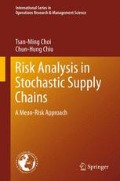Abstract
In this chapter, we carry out mean-risk analysis of multiperiod inventory problems. We select the well-known (R, nQ) multiperiod inventory replenishment model (see Chen and Zheng 1994, 1998; Larsen and Kiesmüller 2007; Li and Sridharan 2008; Shang and Zhou 2010; Lagodimos et al. 2012 and the references therein for more details of the recent developments and extensions of this model) as an example to demonstrate how to perform a mean-risk analysis for multiperiod inventory problems. As shown later on in this chapter, the mean-risk analysis of multiperiod inventory problems is very different from the mean-risk analysis of single-period analysis, in terms of problem formulations and methodology applied. In particular, the (R, nQ) model considers an infinite-horizon replenishment problem under which the total profit/cost is infinite, too. Therefore, the expected (total) profit and the variance of (total) profit cannot be used directly as the “mean” and the “risk,” respectively, in the mean-risk analysis of the (R, nQ) model. To perform the mean-risk analysis, we take the long-run average profit as the “mean,” and propose the variance of on-hand inventory and the variance of one-period profit as “risk” of the (R, nQ) model. We first derive the closed form expressions of the long-run average profit, the variance of on-hand inventory, and the variance of one-period profit. Then, we apply the numerical analysis to demonstrate how to construct the efficient frontier, in the mean-risk sense.
Access this chapter
Tax calculation will be finalised at checkout
Purchases are for personal use only
Notes
- 1.
In the (R, nQ) policy, R represents the reorder point, and nQ is the order quantity in which Q is the order size per batch. In this chapter, we use r to represent the decision variable of reorder point.
- 2.
Notice that Proposition 3.1 is similar to Lemma 1 of Chen and Federgruen (2000).
References
Chen, F., & Federgruen, A. (2000). Mean-variance analysis of basic inventory models. Working paper, Columbia University.
Chen, F., & Zheng, Y. S. (1994). Evaluating echelon stock (R, nQ) policies in serial production/inventory systems with stochastic demand. Management Science, 40, 1262–1275.
Chen, F., & Zheng, Y. S. (1998). Near-optimal echelon-stock (R, nQ) policies in multistage serial systems. Operations Research, 46, 592–602.
Federgruen, A., & Zhang, Y. S. (1992). An efficient algorithm for computing an optimal (r, Q) policy in continuous review stochastic inventory systems. Operations Research, 40, 808–813.
Hadley, G., & Whitin, T. (1961). A family of inventory models. Management Science, 7, 351–371.
Lagodimos, A. G., Christou, I. T., & Skouri, K. (2012). Optimal (r, nQ, T) batch ordering with quantized supplies. Computers and Operations Research, 39, 259–268.
Larsen, C., & Kiesmüller, G. P. (2007). Developing a closed-form cost expression for an (R, s, nQ) policy where the demand process is compound generalized Erlang. Operations Research Letters, 35, 567–572.
Li, X., & Sridharan, V. (2008). Characterizing order processes of using (R, nQ) inventory policies in supply chains. Omega, 36, 1096–1104.
Shang, K. H., & Zhou, S. X. (2010). Optimal and heuristic echelon (r, nQ, T) policies in serial inventory systems with fixed costs. Operations Research, 58, 414–427.
Zipkin, P. (2000). Foundations of inventory management. New York: McGraw-Hill Higher Education.
Author information
Authors and Affiliations
Rights and permissions
Copyright information
© 2012 Springer Science+Business Media New York
About this chapter
Cite this chapter
Choi, TM., Chiu, CH. (2012). Mean-Risk Analysis of Multiperiod Inventory Problems. In: Risk Analysis in Stochastic Supply Chains. International Series in Operations Research & Management Science, vol 178. Springer, New York, NY. https://doi.org/10.1007/978-1-4614-3869-4_3
Download citation
DOI: https://doi.org/10.1007/978-1-4614-3869-4_3
Published:
Publisher Name: Springer, New York, NY
Print ISBN: 978-1-4614-3868-7
Online ISBN: 978-1-4614-3869-4
eBook Packages: Business and EconomicsBusiness and Management (R0)

